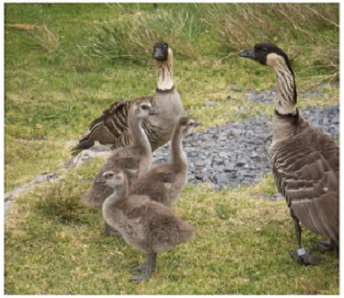Last updated: April 7, 2023
Lesson Plan
Helping Each Other

- Grade Level:
- Lower Elementary: Pre-Kindergarten through Second Grade
- Subject:
- Science
- Lesson Duration:
- 60 Minutes
- State Standards:
- Hawaiʻi Content and Performance Standards III:
SC.K.1.2, SC.1.3.1, SC.1.5.1, SC.2.3.1 - Additional Standards:
- Next Generation Science Standards:
K-ESS3-1, K-LS1-1, 2-LS4-1 - Thinking Skills:
- Remembering: Recalling or recognizing information ideas, and principles. Understanding: Understand the main idea of material heard, viewed, or read. Interpret or summarize the ideas in own words. Analyzing: Break down a concept or idea into parts and show the relationships among the parts.
Essential Question
What is an organism’s job in its habitat?
How do organisms depend on each other and why?
Objective
At the end of this lesson, the students will be able to:
1. Determine an organism’s job in its habitat and describe how they depend on each other.
2. Name three species that are only found within Haleakalā National Park.
3. Recognize that some plants and animals have specific needs and live
Background
In every environment plants and animals depend on each other for food, water, shelter, and space. The survival of different species depends on the health of ecological systems that may be near or far away. The complex relationships within one habitat can be hurt when one of the species is threatened or one of the species becomes extinct.
This lesson ties into the Hawaiian ideas of laulima (working together) and kōkua (help), which are prevalent in the culture. This lesson also connects to prior knowledge of native species. When relating interdependence to a rainforest or local marine habitat, the use of native Hawaiian species is encouraged. For example, in a rainforest, honeycreepers depend on the native plant species for food and shelter, and the birds assist seed dispersal for plant proliferation.
Preparation
Materials Needed:
Helping Each Other Worksheet (included)
Materials
Helping each other worksheet matching symbiotic species
Download Helping Each Other Worksheet
Procedure
Step 1: Introduction
Ask students to think of some animals that they are familiar with, such as their pets or animals that live outside near their homes. Ask them to state the things these animals need to survive, such as water, food, a place to make their home, and enough room to run and roam.
Step 2: Discuss Interdependence
- Ask students to think more carefully about the animals they have described. Discuss the following questions with the class:
- What do the animals eat?
- Where do they live?
- Do plants and animals have jobs? Define niche = A species’ job.
- Explain that even plants and animals have a job in their habitats.
- Describe and ask for examples of how animals depend on other plants and animals around them?
- Define symbiotic = Helpful relationship and interaction between different species in a habitat.
Step 3: Complete the Helping Each Other Worksheet
Students will read the worksheet and match the species to its helping or symbiotic partner.
Step 4: Conclusion
- Ask students for other examples of the interdependence of plants and animals.
- What would happen to these animals if their main food source disappeared?
- What would happen to these animals if the main place where they found shelter no longer existed?
- Is there anything that can be done to help ensure the survival of interdependent species?
- How do the ideas of laulima (working together) and kōkua (helping) tie into this lesson?
Vocabulary
Habitat: A home where a plant or animal finds food, water, shelter and space to survive.
Interdependence: How plants animals depend on one another for survival.
Niche: A species’ job.
Species: A plant, animal, or insect.
Symbiotic: An interdependent relationship that benefits both species.
Additional Resources
Hawai’i Forest Bird Free App by National Park Service.
https://play.google.com/store/apps/details?id=com.ionicframework.hawaiiforestbirds616462
